Solid Oxide Electrolysis, Co-Electrolysis, and Methanation Fundamentals of Performance and History
Abstract
1. Introduction
2. SOE Fundamentals of Performance
3. Co-SOE Fundamentals of Performance
4. Methanation Reactor Fundamentals of Performance
- Without CO intermediate reaction.
- With CO intermediate reaction.
5. The Beginning of High-Temperature Electrolysis
6. Conclusions
Funding
Conflicts of Interest
References
- European Comission. A European Green Deal; European Comission: Brussels, Belgium, 2020. [Google Scholar]
- European Comission. REPowerEU Plan; European Comission: Brussels, Belgium, 2024. [Google Scholar]
- Braack, M.K.; Milewski, N.; Trappe, H. Crossing Social Boundaries in an Immigration Context: Exogamy and Gendered Employment Patterns in Unions in Germany. Gender Issues 2022, 39, 142–176. [Google Scholar] [CrossRef] [PubMed]
- Kupecki, J.; Motylinski, K.; Jagielski, S.; Wierzbicki, M.; Brouwer, J.; Naumovich, Y.; Skrzypkiewicz, M. Energy Analysis of a 10 KW-Class Power-to-Gas System Based on a Solid Oxide Electrolyzer (SOE). Energy Convers. Manag. 2019, 199, 111934. [Google Scholar] [CrossRef]
- Milewski, J.; Kupecki, J.; Szczęśniak, A.; Uzunow, N. Hydrogen Production in Solid Oxide Electrolyzers Coupled with Nuclear Reactors. Int. J. Hydrog. Energy 2020, 46, 35765–35776. [Google Scholar] [CrossRef]
- Eric, T.; Tony, W.; Casey, B.; Micah, C.; Michael, P.; Mark, R.; Randy, P. Solid Oxide Based Electrolysis and Stack Technology with Ultra-High Electrolysis Current Density (>3 A/Cm2) and Efficiency; A FuelCell Energy Company: Torrington, CT, USA, 2018. [Google Scholar]
- Ebbesen, S.D.; Graves, C.; Mogensen, M. Production of Synthetic Fuels by Co-Electrolysis of Steam and Carbon Dioxide. Int. J. Green Energy 2009, 6, 646–660. [Google Scholar] [CrossRef]
- Omojola, K. High Temperature Co Electrolysis of Carbon Dioxide and Steam in a Solid Oxide Cell for Synthesis Gas Production. Ph.D. Thesis, The University of Sheffield, Sheffield, UK, 2015. [Google Scholar]
- Chen, M.; Høgh, J.V.T.; Nielsen, J.U.; Bentzen, J.J.; Ebbesen, S.D.; Hendriksen, P.V. High Temperature Co-Electrolysis of Steam and CO2 in an SOC Stack: Performance and Durability. Fuel Cells 2013, 13, 638–645. [Google Scholar] [CrossRef]
- Wang, Y.; Liu, T.; Lei, L.; Chen, F. High Temperature Solid Oxide H2O/CO2 Co-Electrolysis for Syngas Production. Fuel Process. Technol. 2017, 161, 248–258. [Google Scholar] [CrossRef]
- Zheng, Y.; Wang, J.; Yu, B.; Zhang, W.; Chen, J.; Qiao, J.; Zhang, J. A Review of High Temperature Co-Electrolysis of H2O and CO2 to Produce Sustainable Fuels Using Solid Oxide Electrolysis Cells (SOECs): Advanced Materials and Technology. Chem. Soc. Rev. 2017, 46, 1427–1463. [Google Scholar] [CrossRef]
- Milewski, J.; Podhurska, V.; Martsinchyk, A.; Vasyliv, B.; Dybinski, O. Experimental and Theoretical Investigation of Contact Resistance in Molten Carbonate Fuel Cells. J. Power Sources 2023, 568, 232952. [Google Scholar] [CrossRef]
- Elikan, L.; Morris, J.P.; Wu, C.K. Development of a Solid Electrolyte Carbon Dioxide and Water Reduction System for Oxygen Recovery; NTRS: Chicago, IL, USA, 1972. [Google Scholar]
- Weissbart, J.; Smart, W.H. Study of Electrolytic Dissociation of CO2-H2O Using a Solid Oxide Electrolyte. NASA CR-680. In NASA Contractor Report; NASA CR: Washington, DC, USA, 1967; pp. 1–92. [Google Scholar]
- Doenitz, W.; Schmidberger, R.; Steinheil, E.; Streicher, R. Hydrogen Production by High Temperature Electrolysis of Water Vapour. Int. J. Hydrogen Energy 1980, 5, 55–63. [Google Scholar] [CrossRef]
- Dönitz, W.; Erdle, E. High-Temperature Electrolysis of Water Vapor—Status of Development and Perspectives for Application. Int. J. Hydrogen Energy 1985, 10, 291–295. [Google Scholar] [CrossRef]
- Isenberg, A. Energy Conversion via Solid Oxide Electrolyte Electrochemical Cells at High Temperatures. Solid State Ion. 1981, 3–4, 431–437. [Google Scholar] [CrossRef]
- Tao, G. Study of Carbon Dioxide Electrolysis at Electrode/Electrolyte Interface: Part I. Pt/YSZ Interface. Solid State Ion. 2004, 175, 615–619. [Google Scholar] [CrossRef]
- Tao, G. Study of Carbon Dioxide Electrolysis at Electrode/Electrolyte Interface: Part II. Pt-YSZ Cermet/YSZ Interface. Solid State Ion. 2004, 175, 621–624. [Google Scholar] [CrossRef]
- Ebbesen, S.D.; Høgh, J.; Nielsen, K.A.; Nielsen, J.U.; Mogensen, M. Durable SOC Stacks for Production of Hydrogen and Synthesis Gas by High Temperature Electrolysis. Int. J. Hydrogen Energy 2011, 36, 7363–7373. [Google Scholar] [CrossRef]
- Ebbesen, S.D.; Knibbe, R.; Mogensen, M. Co-Electrolysis of Steam and Carbon Dioxide in Solid Oxide Cells. J. Electrochem. Soc. 2012, 159, F482–F489. [Google Scholar] [CrossRef]
- Ebbesen, S.D.; Jensen, S.H.; Hauch, A.; Mogensen, M.B. High Temperature Electrolysis in Alkaline Cells, Solid Proton Conducting Cells, and Solid Oxide Cells. Chem. Rev. 2014, 114, 10697–10734. [Google Scholar] [CrossRef]
- Morgenthaler, S.; Kuckshinrichs, W.; Witthaut, D. Optimal System Layout and Locations for Fully Renewable High Temperature Co-Electrolysis. Appl. Energy 2020, 260, 114218. [Google Scholar] [CrossRef]
- Schreiber, A.; Peschel, A.; Hentschel, B.; Zapp, P. Life Cycle Assessment of Power-to-Syngas: Comparing High Temperature Co-Electrolysis and Steam Methane Reforming. Front. Energy Res. 2020, 8, 287. [Google Scholar] [CrossRef]
- Bocanegra-Bernal, M.H.; de la Torre, S.D. Phase Transitions in Zirconium Dioxide and Related Materials for High Performance Engineering Ceramics. J. Mater. Sci. 2002, 37, 4947–4971. [Google Scholar] [CrossRef]
- Laguna-Bercero, M.A. Recent Advances in High Temperature Electrolysis Using Solid Oxide Fuel Cells: A Review. J. Power Sources 2012, 203, 4–16. [Google Scholar] [CrossRef]
- Yue, X.; Yan, A.; Zhang, M.; Liu, L.; Dong, Y.; Cheng, M. Investigation on Scandium-Doped Manganate La0.8Sr0.2Mn1-XScxO3-Cathode for Intermediate Temperature Solid Oxide Fuel Cells. J. Power Sources 2008, 185, 691–697. [Google Scholar] [CrossRef]
- Ai, N.; Li, N.; He, S.; Cheng, Y.; Saunders, M.; Chen, K.; Zhang, T.; Jiang, S.P. Highly Active and Stable Er0.4Bi1.6O3 Decorated La0.76Sr0.19MnO3+δ Nanostructured Oxygen Electrodes for Reversible Solid Oxide Cells. J. Mater. Chem. A 2017, 5, 12149–12157. [Google Scholar] [CrossRef]
- Chauveau, F.; Mougin, J.; Bassat, J.M.; Mauvy, F.; Grenier, J.C. A new anode material for solid oxide electrolyser: The neodymium nickelate Nd2NiO4+δ. J. Power Sources 2010, 195, 744–749. [Google Scholar] [CrossRef]
- Martsinchyk, A.; Szczęśniak, A.; Martsinchyk, K.; Dybiński, O.; Cinti, G.; Milewski, J.; Shuhayeu, P.; Łazor, M.; Ćwieka, K.; Skibiński, J.; et al. Molten Carbonate Electrolyzer for Synthetic Fuel Generation. J. Power Sources 2025, 628, 235741. [Google Scholar] [CrossRef]
- Bustamante, F.; Enick, R.M.; Cugini, A.V.; Killmeyer, R.P.; Howard, B.H.; Rothenberger, K.S.; Ciocco, M.V.; Morreale, B.D.; Chattopadhyay, S.; Shi, S. High-Temperature Kinetics of the Homogeneous Reverse Water–Gas Shift Reaction. AIChE J. 2004, 50, 1028–1041. [Google Scholar] [CrossRef]
- Pekridis, G.; Kalimeri, K.; Kaklidis, N.; Vakouftsi, E.; Iliopoulou, E.F.; Athanasiou, C.; Marnellos, G.E. Study of the Reverse Water Gas Shift (RWGS) Reaction over Pt in a Solid Oxide Fuel Cell (SOFC) Operating under Open and Closed-Circuit Conditions. Catal. Today 2007, 127, 337–346. [Google Scholar] [CrossRef]
- Sun, Q.; Liu, C.-W.; Pan, W.; Zhu, Q.-M.; Deng, J.-F. In Situ IR Studies on the Mechanism of Methanol Synthesis over an Ultrafine Cu/ZnO/Al2O3 Catalyst. Appl. Catal. A Gen. 1998, 171, 301–308. [Google Scholar] [CrossRef]
- Zhao, K.; Bkour, Q.; Hou, X.; Kang, S.W.; Park, J.C.; Norton, M.G.; Yang, J.-I.; Ha, S. Reverse Water Gas Shift Reaction over CuFe/Al2O3 Catalyst in Solid Oxide Electrolysis Cell. Chem. Eng. J. 2018, 336, 20–27. [Google Scholar] [CrossRef]
- Wang, L.; Liu, H.; Liu, Y.; Chen, Y.; Yang, S. Effect of Precipitants on Ni-CeO2 Catalysts Prepared by a Co-Precipitation Method for the Reverse Water-Gas Shift Reaction. J. Rare Earths 2013, 31, 969–974. [Google Scholar] [CrossRef]
- Choi, S.; Sang, B.-I.; Hong, J.; Yoon, K.J.; Son, J.-W.; Lee, J.-H.; Kim, B.-K.; Kim, H. Catalytic Behavior of Metal Catalysts in High-Temperature RWGS Reaction: In-Situ FT-IR Experiments and First-Principles Calculations. Sci. Rep. 2017, 7, 41207. [Google Scholar] [CrossRef]
- Bogolowski, N.; Sánchez Batalla, B.; Shin, B.; Drillet, J.-F. Activity of La0.75Sr0.25Cr0.5Mn0.5O3−δ, Ni3Sn2 and Gd-doped CeO2 towards the reverse water-gas shift reaction and carburisation for a high-temperature H2O/CO2 co-electrolysis. RSC Adv. 2020, 10, 10285–10296. [Google Scholar] [CrossRef] [PubMed]
- Sabatier, P.; Senderens, J.B. New Methane Synthesis. C. R. Acad. Sci. Paris 1902, 134, 514–516. [Google Scholar]
- Sun, D.; Simakov, D.S.A. Thermal management of a Sabatier reactor for CO2 conversion into CH4: Simulation-based analysis. J. CO2 Util. 2017, 21, 368–382. [Google Scholar] [CrossRef]
- Held, M.; Schollenberger, D.; Sauerschell, S.; Bajohr, S.; Kolb, T. Power-to-Gas: CO2 Methanation Concepts for SNG Production at the Engler-Bunte-Institut. Chem. Ing. Tech. 2020, 92, 595–602. [Google Scholar] [CrossRef]
- Schweitzer, J.M.; Viguié, J.C. Reactor Modeling of a Slurry Bubble Column for Fischer-Tropsch Synthesis. Oil Gas Sci. Technol. Rev. L’IFP 2009, 64, 63–77. [Google Scholar] [CrossRef]
- Mebrahtu, C.; Krebs, F.; Abate, S.; Perathoner, S.; Centi, G.; Palkovits, R. CO2 Methanation: Principles and Challenges. In Studies in Surface Science and Catalysis; Elsevier: Amsterdam, The Netherlands, 2019; pp. 85–103. [Google Scholar]
- Medsforth, S. CLXIX.—Promotion of Catalytic Reactions. Part I. J. Chem. Soc. Trans. 1923, 123, 1452–1469. [Google Scholar] [CrossRef]
- Pichler, H. Accounting in Hydrogenation. 1943. Available online: https://www.osti.gov/biblio/6675880 (accessed on 15 September 2024).
- Choe, S.J.; Kang, H.J. Adsorbed Carbon Formation and Carbon Hydrogenation for CO2 Methanation on the Ni(111) Surface: ASED-MO Study. Korean Chem. Soc. 2005, 26, 1682–1688. [Google Scholar]
- Martsinchyk, A. Using MCFC for Capturing CO2 from Flue Gases and Delivering to Sabatier Reactor for SNG Synthesis; Institute of Heat Engineering (IHE): Warsaw, Poland, 2020. [Google Scholar]
- Jiajian, G.; Wang, Y.; Ping, Y.; Hu, D.; Xu, G.; Gu, F.; Su, F. A Thermodynamic Analysis of Methanation Reactions of Carbon Oxides for the Production of Synthetic Natural Gas. RSC Adv. 2012, 2, 2358–2368. [Google Scholar] [CrossRef]
- Stangeland, K.; Kalai, D.; Li, H.; Yu, Z. CO2 Methanation: The Effect of Catalysts and Reaction Conditions. Energy Procedia 2017, 105, 2022–2027. [Google Scholar] [CrossRef]
- Martsinchyk, K.; Martsinchyk, A.; Łazor, M.; Shuhayeu, P.; Kupecki, J.; Niemczyk, A.; Błesznowski, M.; Milewski, J. Feasibility Study and Techno-Economic Assessment of Power-to-Gas (P2G) Technology Based on Solid Oxide Electrolysis (SOE). J. Environ. Manag. 2024, 354, 120425. [Google Scholar] [CrossRef]
- Van Troostwijk, A.P.; Deiman, J.R. Sur Une Manière de Décomposer l’Eau En Air Inflammable et En Air Vital. Obs. Phys. 1789, 35, 369–378. [Google Scholar]
- Paets van Troostwijk, A.; Deiman, J.R. Über Die Zerlegungdes Wassers in Brennbare Und Lebensluft Durch Denelektrischen Funken. Ann. Phys. 1790, 2, 130–141. [Google Scholar]
- Troostwijk, P.A. Schets Der Nieuwe Ontdekkingenomtrent Het Water. Algem. Mag. Wetensch. Kunst Smaak 1790, 4, 909–941. [Google Scholar]
- Berg, H. Johann Wilhelm Ritter–The Founder of Scientific Electrochemistry. Rev. Polarogr. 2008, 54, 99–103. [Google Scholar] [CrossRef][Green Version]
- Zhang, J.; Zhang, L.; Liu, H.; Sun, A.; Liu, R.-S. Electrochemical Technologies for Energy Storage and Conversion, 2 Volume Set; John Wiley & Sons: Hoboken, NJ, USA, 2011; Volume 1, ISBN 3527328696. [Google Scholar]
- Kreuter, W.; Hofmann, H. Electrolysis: The Important Energy Transformer in a World of Sustainable Energy. Int. J. Hydrog. Energy 1998, 23, 661–666. [Google Scholar] [CrossRef]
- Péra, M.-C.; Hissel, D.; Gualous, H.; Turpin, C. Electrochemical Components; John Wiley & Sons, Inc.: Hoboken, NJ, USA, 2013. [Google Scholar]
- Katz, E. Electrochemical Contributions: William Nicholson (1753–1815). Electrochem. Sci. Adv. 2021, 1, e2160003. [Google Scholar] [CrossRef]
- de Levie, R. The Electrolysis of Water. J. Electroanal. Chem. 1999, 476, 92–93. [Google Scholar] [CrossRef]
- Faraday, M. On Electrical Decomposition. Philos. Trans. R. Soc. 1834, 124, 77–122. [Google Scholar] [CrossRef]
- Zhou, R.E. How to Offer the Optimal Demonstration of the Electrolysis of Water. J. Chem. Educ. 1996, 73, 786. [Google Scholar] [CrossRef]
- Hendricks, L.J.; Williams, J.T. Demonstration of Electrochemical Cell Properties by a Simple, Colorful Oxidation-Reduction Experiment. Chem. Educ. 1982, 59, 586–587. [Google Scholar] [CrossRef]
- Shakhashiri, B.Z. Chemical Demonstrations: A Handbook for Teachers of Chemistry; University of Wisconsin Press: Madison, WI, USA, 1992. [Google Scholar]
- Hugerat, M. New Inexpensive Apparatus for Electrolysis. Chem. Educ. J. 2008, 11, 11–19. [Google Scholar]
- Borja, A.N. Desarrollo de Un Sistema Modular de Reacción Para El Estudio de La Producción de Oxígeno e Hidrógeno a Partir de La Electrólisis Del Agua; Benemérita Universidad Autónoma de Puebla: Puebla, Mexico, 2018. [Google Scholar]
- Guillet, P.M.N. Hydrogen Production by Electrolysis; U.S. Department of Energy: Washington, DC, USA, 2015.
- Zdansky, E.A. Pressure Electrolyzers. U.S. Patent 2,717,872A, 19 September 1955. [Google Scholar]
- Ansar, A.S.; Gago, A.S.; Razmjooei, F.; Reißner, R.; Xu, Z.; Friedrich, K.A. Chapter 5-Alkaline Electrolysis—Status and Prospects. In Electrochemical Power Sources: Fundamentals, Systems, and Applications; Smolinka, T., Garche, J., Eds.; Elsevier: Amsterdam, The Netherlands, 2022; pp. 165–198. ISBN 978-0-12-819424-9. [Google Scholar]
- Funke, K. Solid State Ionics: From Michael Faraday to Green Energy-The European Dimension. Sci. Technol. Adv. Mater. 2013, 14, 43502. [Google Scholar] [CrossRef] [PubMed]
- Doenitz, W. Hydrogen Production with HOT ELLY. Dornier-Post 1977, 1, 17–19. [Google Scholar]
- Hamilton Standard Division of United Aircraft Corporation. Trade-off Study and Conceptual Design of Regenarative Advanced Life Support System (AILSS)-NASA-CR1458; NASA: Washington, DC, USA, 1970.
- Elikan, L.; Morris, J.P. Solid Electrolyte System for Oxygen Regeneration. NASA CR-1359; NASA: Washington, DC, USA, 1969.
- Weissbart, J.; Smart, W.H. A Two-Cell 8-Ampere CO2-H2O Solid Electrolyte Electrolyzer for Oxygen Production; National Aeronautics and Space Administration AMES Research Center: Moffett Field, CA, USA, 1970. [Google Scholar]
- Smart, W.; Weissbar, J. A 127-Ampere CO2-H2O Solid Oxide Electrolyzer-Reactor System For Production of Oxygen; Electrochemical Soc Inc.: Pennington, NJ, USA, 1970. [Google Scholar]
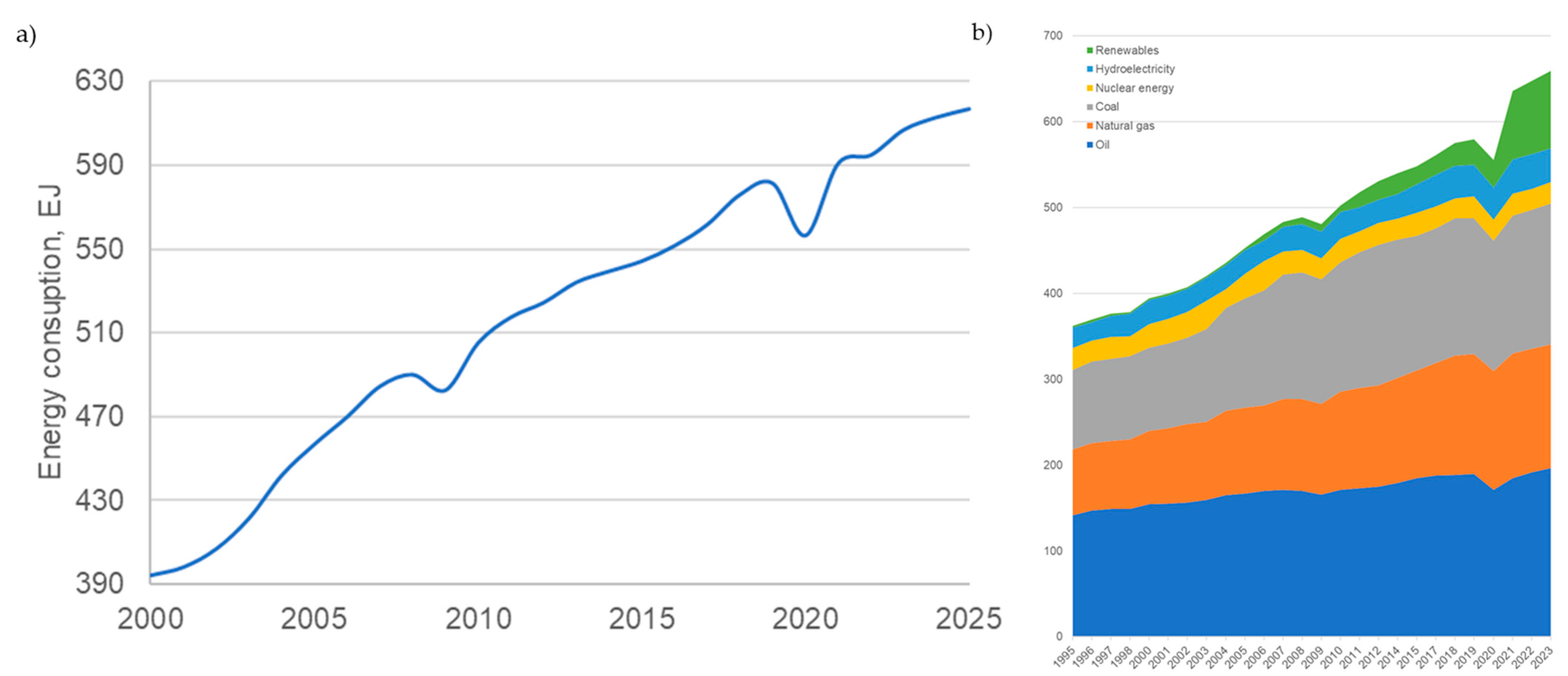
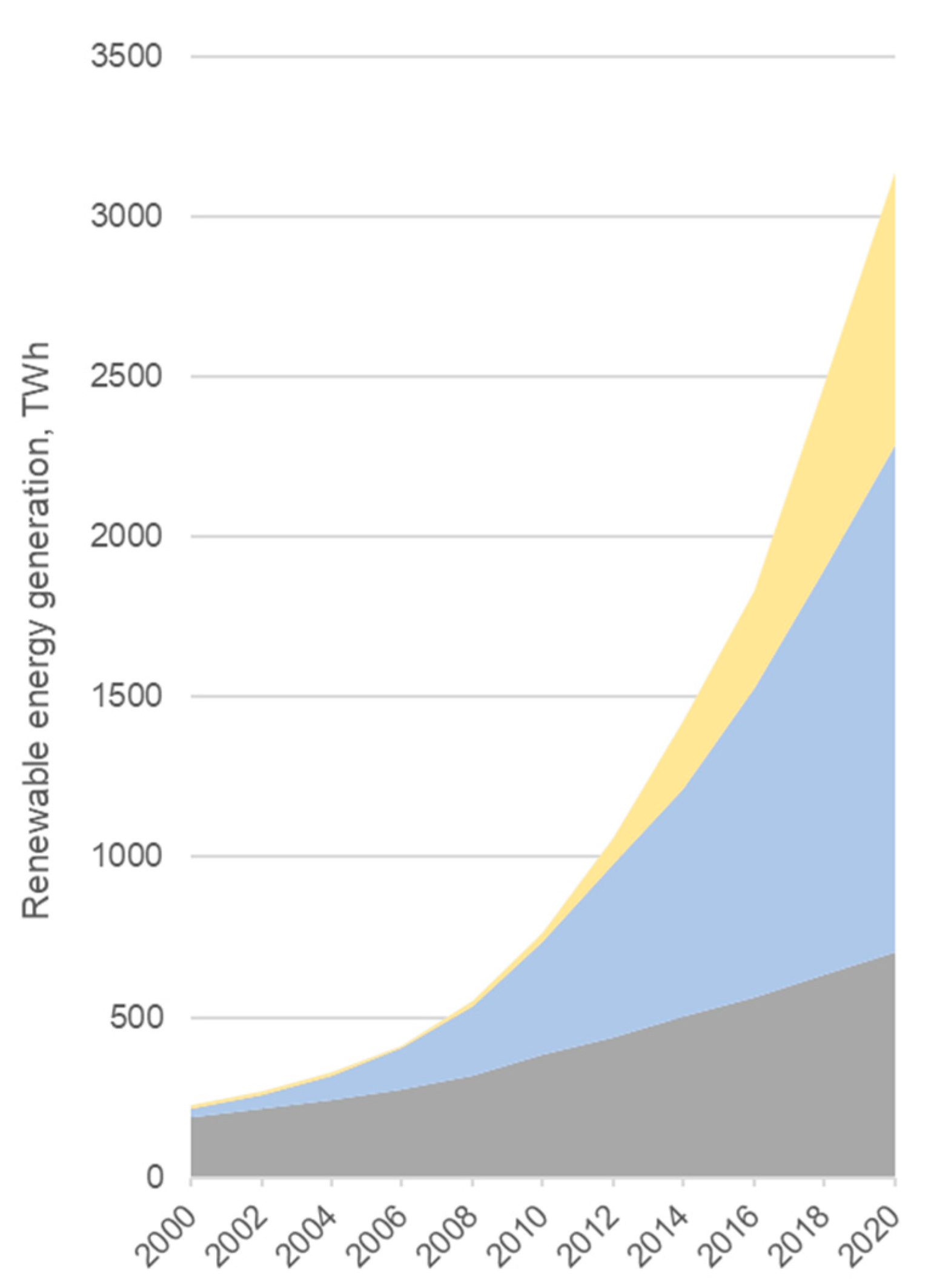


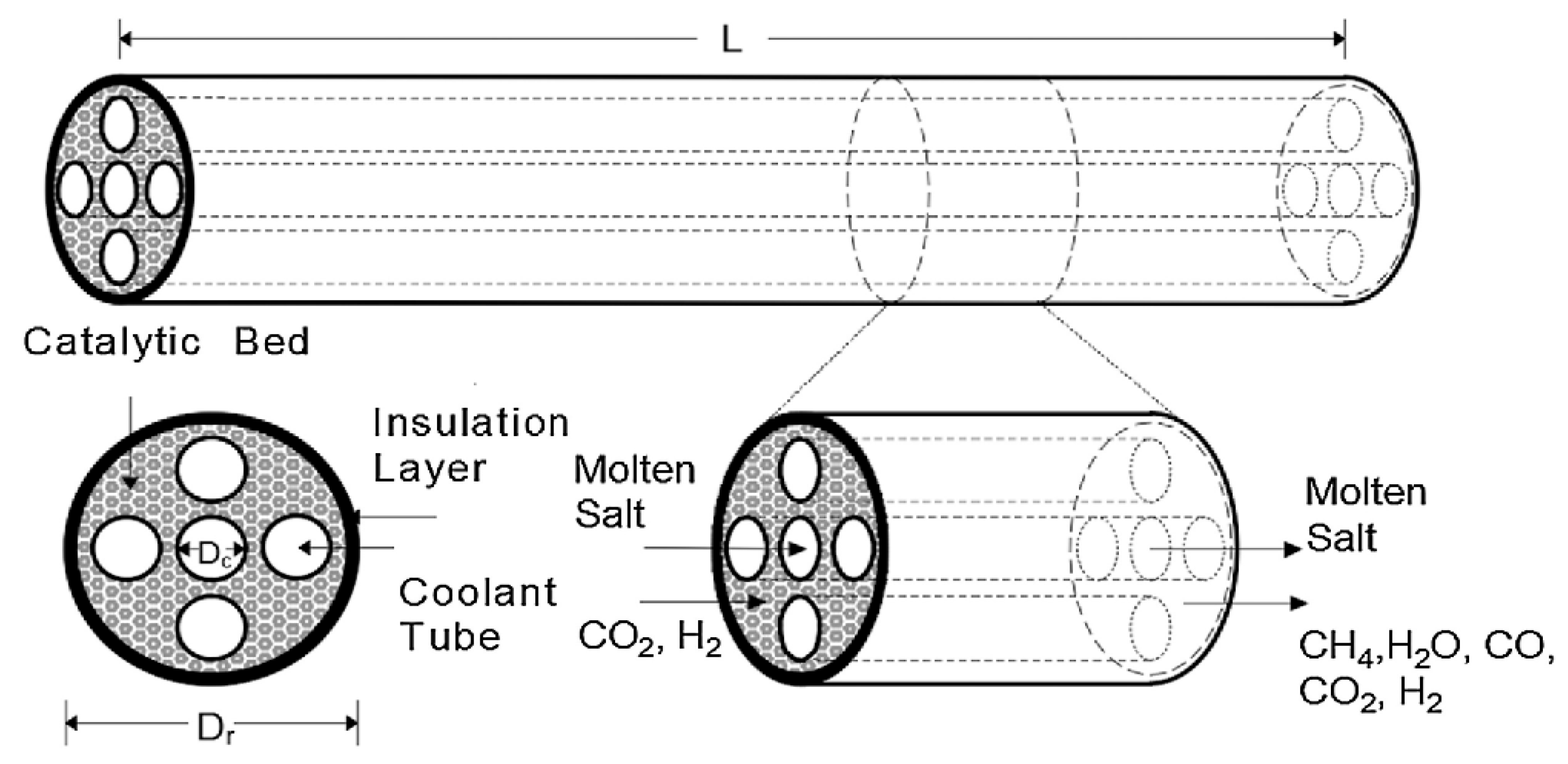
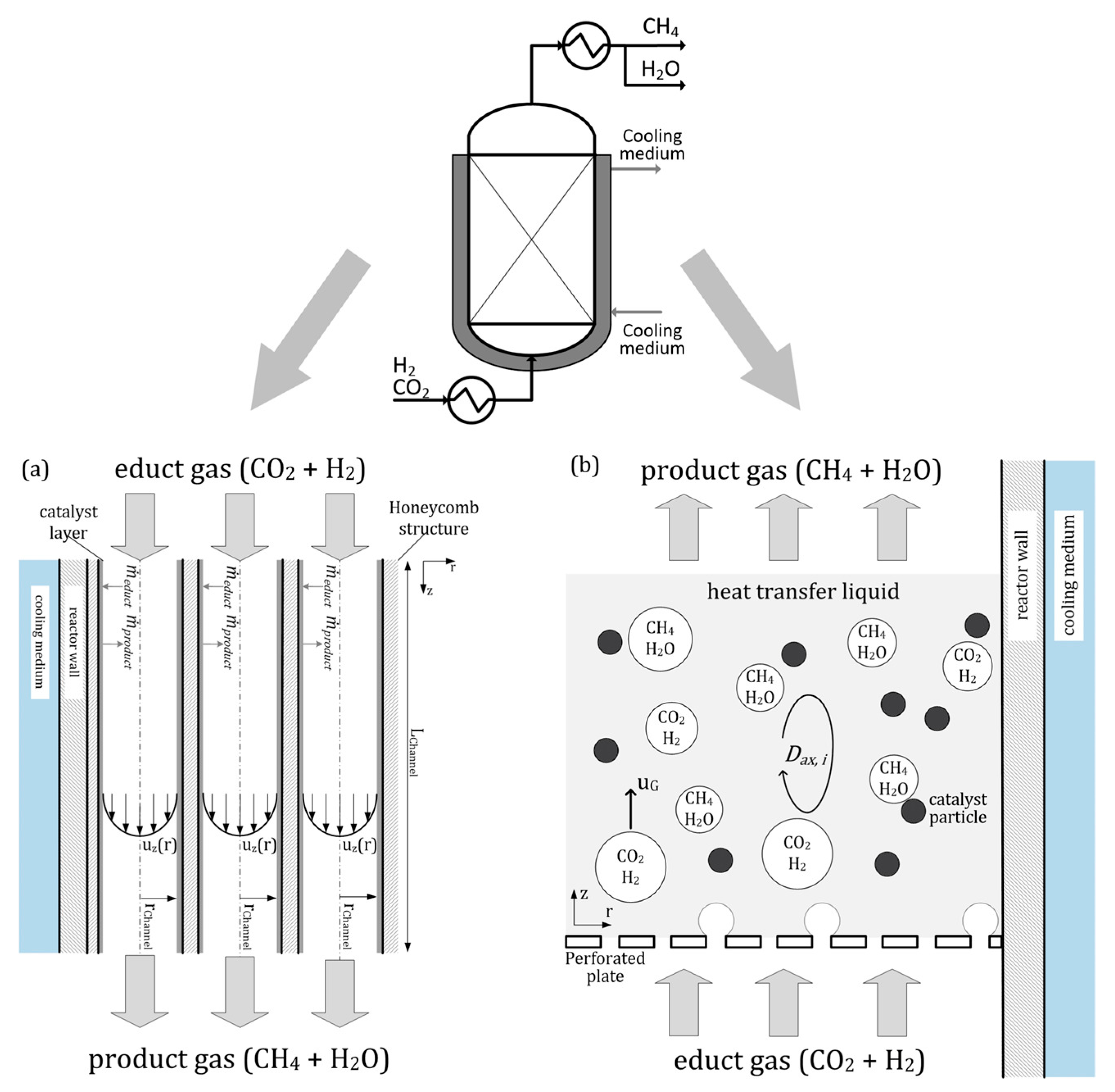


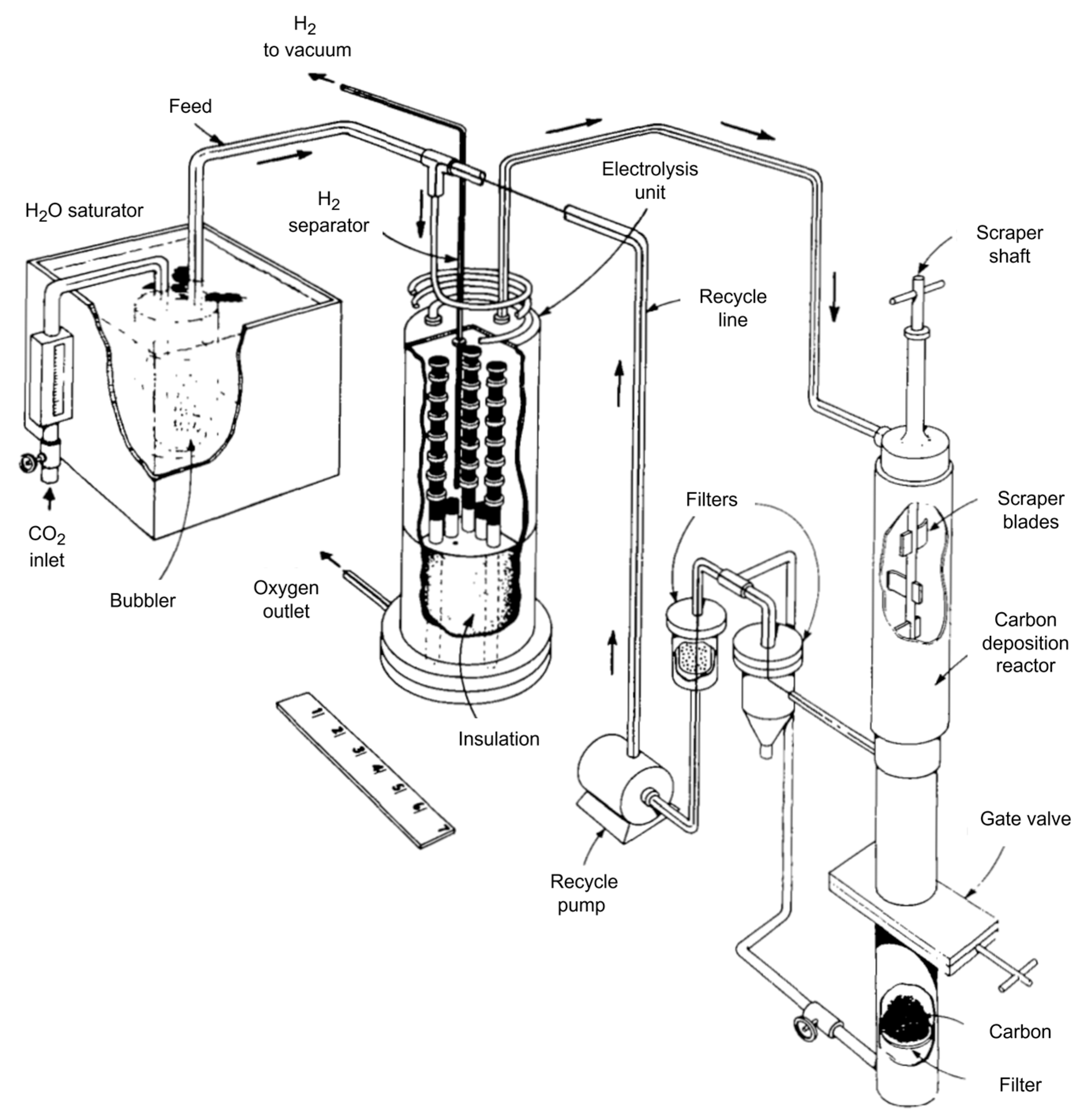
| Packed Bed | Honeycomb | Slurry Bubble Column |
|---|---|---|
| This design, exemplified by the heat exchanger model, features high CO2; conversion rates and effective thermal management. The inclusion of molten salt cooling tubes ensures steady heat dissipation, which is critical for the exothermic Sabatier reaction. Packed-bed reactors are well suited for industrial-scale methane production due to their high throughput and thermal stability, but they may face challenges with heat transfer limitations at larger scales and under dynamic load conditions. | This structured, fixed-bed design offers high CH4 productivity and excellent load flexibility, making it a strong candidate for grid-balancing applications where rapid response to fluctuating energy inputs is required. However, maintaining uniform flow distribution and catalyst activity across the reactor channels can be challenging, particularly under varying operational loads. | This reactor excels in dynamic operation due to the intimate contact between gaseous reactants, liquid medium, and solid catalyst. Its high heat capacity, facilitated by the cooling jacket and heat transfer fluid, provides superior thermal management. However, it has lower specific methane generation compared to the other designs, limiting its efficiency for large-scale production. Its ability to adapt to intermittent power supply makes it particularly advantageous for renewable energy integration scenarios. |
| Date | Event/Innovation | Ref. |
|---|---|---|
| 1789 | Adriaan Paets van Troostwijk and Johan Rudolph Deiman utilized an electrostatic generator to create a discharge between two gold electrodes submerged in water. | [50,51,52,56] |
| 1800 | Independently, William Nicholson, Anthony Carlisle, and Johann Wilhelm Ritter successfully demonstrated the fundamental principle of water electrolysis. | [56,57,58] |
| 1834 | Michael Faraday refined and established the foundational laws governing the electrolysis process. | [56,59] |
| 1866 | August Wilhelm von Hofmann designed a voltameter capable of electrolysing water and quantifying the resultant products. | [56,60,61,62,63] |
| 1888 | Dmitry Lachinov pioneered the industrial method for producing hydrogen and oxygen through electrolysis. | [54,56] |
| 1899 | Dr. O. Schmidt introduced the first industrial bipolar electrolyser, utilizing the filter press design and produced by Oerlikon. | [56] |
| 1924 | Jacob Emil Noeggerath designed the inaugural electrolyser capable of operating under high pressures (up to 100 bars) and secured a patent for this invention. | [56,64] |
| 1948 | Ewald Arno Zdansky was the innovator behind the first pressurized industrial electrolyser, developed for the Swiss group Lonza. | [64,65,66] |
| 1951 | The German company Lurgi commercialized the initial high-pressure electrolyser (30 bars), having acquired the patent from Lonza. | [66,67] |
| 1966 | The first solid polymer electrolyte system (SPE) was developed by General Electric. | [55,56] |
Disclaimer/Publisher’s Note: The statements, opinions and data contained in all publications are solely those of the individual author(s) and contributor(s) and not of MDPI and/or the editor(s). MDPI and/or the editor(s) disclaim responsibility for any injury to people or property resulting from any ideas, methods, instructions or products referred to in the content. |
© 2024 by the authors. Licensee MDPI, Basel, Switzerland. This article is an open access article distributed under the terms and conditions of the Creative Commons Attribution (CC BY) license (https://creativecommons.org/licenses/by/4.0/).
Share and Cite
Martsinchyk, K.; Martsinchyk, A.; Milewski, J. Solid Oxide Electrolysis, Co-Electrolysis, and Methanation Fundamentals of Performance and History. Energies 2024, 17, 6486. https://doi.org/10.3390/en17246486
Martsinchyk K, Martsinchyk A, Milewski J. Solid Oxide Electrolysis, Co-Electrolysis, and Methanation Fundamentals of Performance and History. Energies. 2024; 17(24):6486. https://doi.org/10.3390/en17246486
Chicago/Turabian StyleMartsinchyk, Katsiaryna, Aliaksandr Martsinchyk, and Jaroslaw Milewski. 2024. "Solid Oxide Electrolysis, Co-Electrolysis, and Methanation Fundamentals of Performance and History" Energies 17, no. 24: 6486. https://doi.org/10.3390/en17246486
APA StyleMartsinchyk, K., Martsinchyk, A., & Milewski, J. (2024). Solid Oxide Electrolysis, Co-Electrolysis, and Methanation Fundamentals of Performance and History. Energies, 17(24), 6486. https://doi.org/10.3390/en17246486







